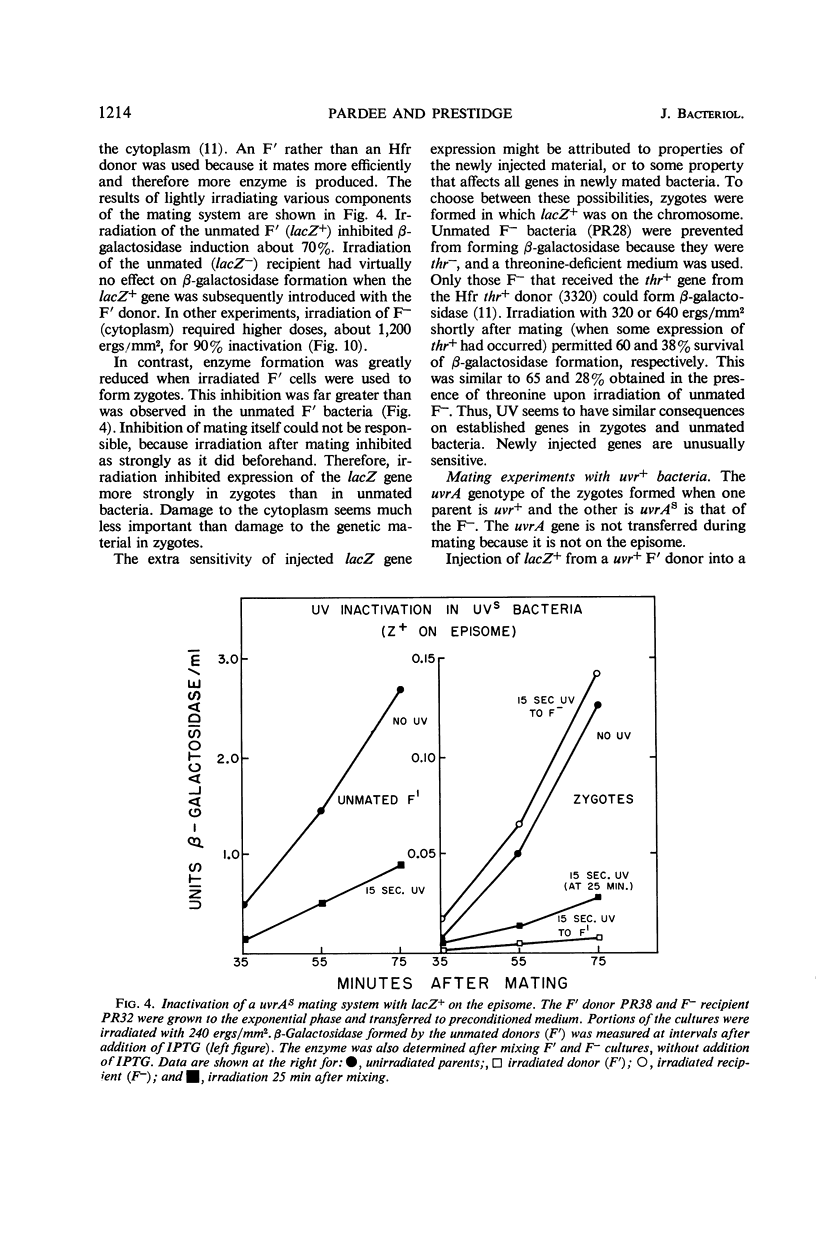Abstract
Inhibition by ultraviolet light of β-galactosidase and alkaline phosphatase synthesis was investigated in both ultraviolet (UV)-sensitive and UV-resistant (wild-type) Escherichia coli, with the objective of determining the sensitivity of various targets. Kinetics of enzyme formation by unmated bacteria and in mating systems, in which the donor provided the specific genetic material and the recipient the cytoplasm, permit the following conclusions regarding the sensitivity of various targets. Catabolite repression resulting from UV damage causes most of the inhibition of β-galactosidase formation. When it is largely eliminated by a step-down in nutrition, the principal target in UV-sensitive bacteria appears to be the structural gene (lacZ+), but damage to the cytoplasm is also important. Transitory inhibition by inactivation of messenger ribonucleic acid is also observed. In wild-type bacteria, repair reduces the importance of lesions in deoxyribonucleic acid sufficiently that cytoplasmic damage appears to be at least as important. Repair occurs within 10 min, as shown by recovery of enzyme-synthesizing ability. Caffeine and proflavine prevent recovery. Newly mated bacteria respond to irradiation very differently than do unmated bacteria. The β-galactosidase or alkaline phosphatase structural gene (lacZ+ or phoP+) is much more inhibited after it is transferred than it is in unmated bacteria. This sensitivity seems to depend on a sensitive state of the injected material, rather than on a different physiological condition of the entire zygote. Irradiation of recipient uvr+ bacteria much more strongly inhibited expression of injected genes than if the F− was uvrs. Studies on mating systems are not very useful for learning about the function of unmated bacteria.
Full text
PDF









Selected References
These references are in PubMed. This may not be the complete list of references from this article.
- BOWNE S. W., Jr, ROGERS P. Ultraviolet light and enzyme synthesis. J Mol Biol. 1962 Jul;5:90–96. doi: 10.1016/s0022-2836(62)80064-3. [DOI] [PubMed] [Google Scholar]
- ECHOLS H., GAREN A., GAREN S., TORRIANI A. Genetic control of repression of alkaline phosphatase in E. coli. J Mol Biol. 1961 Aug;3:425–438. doi: 10.1016/s0022-2836(61)80055-7. [DOI] [PubMed] [Google Scholar]
- Howard-Flanders P., Theriot L. Mutants of Escherichia coli K-12 defective in DNA repair and in genetic recombination. Genetics. 1966 Jun;53(6):1137–1150. doi: 10.1093/genetics/53.6.1137. [DOI] [PMC free article] [PubMed] [Google Scholar]
- Joset F., Wood T. H. Modification of conjugation in Escherichia coli K-12 by ultraviolet irradiation. Genetics. 1966 Feb;53(2):343–356. doi: 10.1093/genetics/53.2.343. [DOI] [PMC free article] [PubMed] [Google Scholar]
- LIEB M. DARK REPAIR OF UV INDUCTION IN K12 (LAMBDA). Virology. 1964 Jul;23:381–388. doi: 10.1016/0042-6822(64)90260-0. [DOI] [PubMed] [Google Scholar]
- PARDEE A. B., PRESTIDGE L. S. INACTIVATION OF BETA-GALACTOSIDASE INDUCTION BY ULTRAVIOLET LIGHT. Biochim Biophys Acta. 1963 Dec 20;76:614–621. [PubMed] [Google Scholar]
- PARDEE A. B., PRESTIDGE L. S. The initial kinetics of enzyme induction. Biochim Biophys Acta. 1961 Apr 29;49:77–88. doi: 10.1016/0006-3002(61)90871-x. [DOI] [PubMed] [Google Scholar]
- PRESTIDGE L. S., PARDEE A. B. A SECOND PERMEASE FOR METHYL-THIO-BETA-D-GALACTOSIDE IN ESCHERICHIA COLI. Biochim Biophys Acta. 1965 May 4;100:591–593. doi: 10.1016/0304-4165(65)90029-2. [DOI] [PubMed] [Google Scholar]
- RILEY M., PARDEE A. B. beta-Galactosidase formation following decay of 32P in Escherichia coli zygotes. J Mol Biol. 1962 Jul;5:63–75. doi: 10.1016/s0022-2836(62)80061-8. [DOI] [PubMed] [Google Scholar]
- RUSHIZKY G. W., RILEY M., PRESTIDGE L. S., PARDEE A. B. Inactivation of enzyme formation by ultraviolet light. I. Action spectra and size of the sensitive unit. Biochim Biophys Acta. 1960 Dec 4;45:70–76. doi: 10.1016/0006-3002(60)91426-8. [DOI] [PubMed] [Google Scholar]
- SWENSON P. A., SETLOW R. B. BETA-GALACTOSIDASE: INACTIVATION OF ITS MESSENGER RNA BY ULTRAVIOLET IRRADIATION. Science. 1964 Nov 6;146(3645):791–794. doi: 10.1126/science.146.3645.791. [DOI] [PubMed] [Google Scholar]
- Setlow R. B. Cyclobutane-type pyrimidine dimers in polynucleotides. Science. 1966 Jul 22;153(3734):379–386. doi: 10.1126/science.153.3734.379. [DOI] [PubMed] [Google Scholar]


